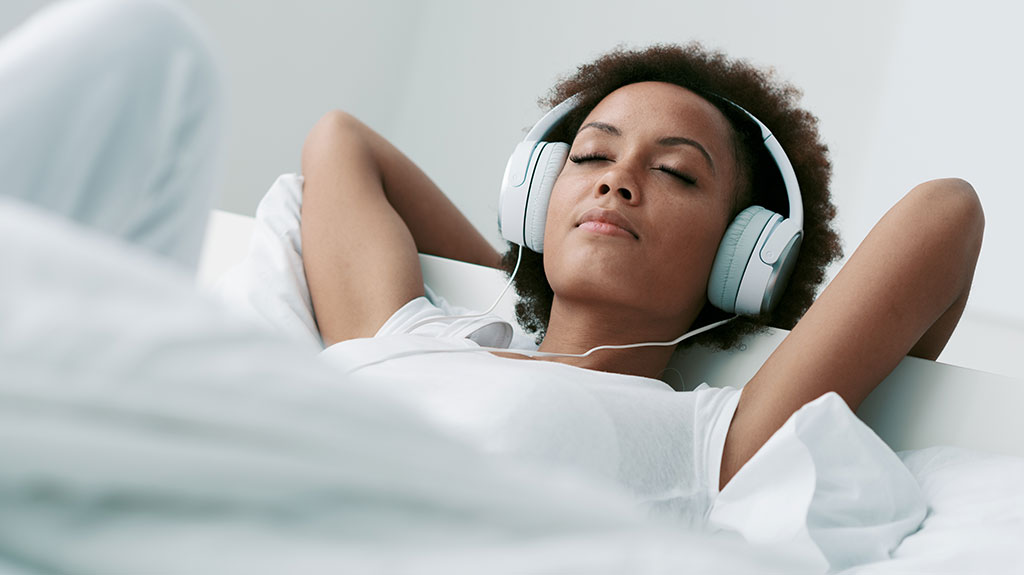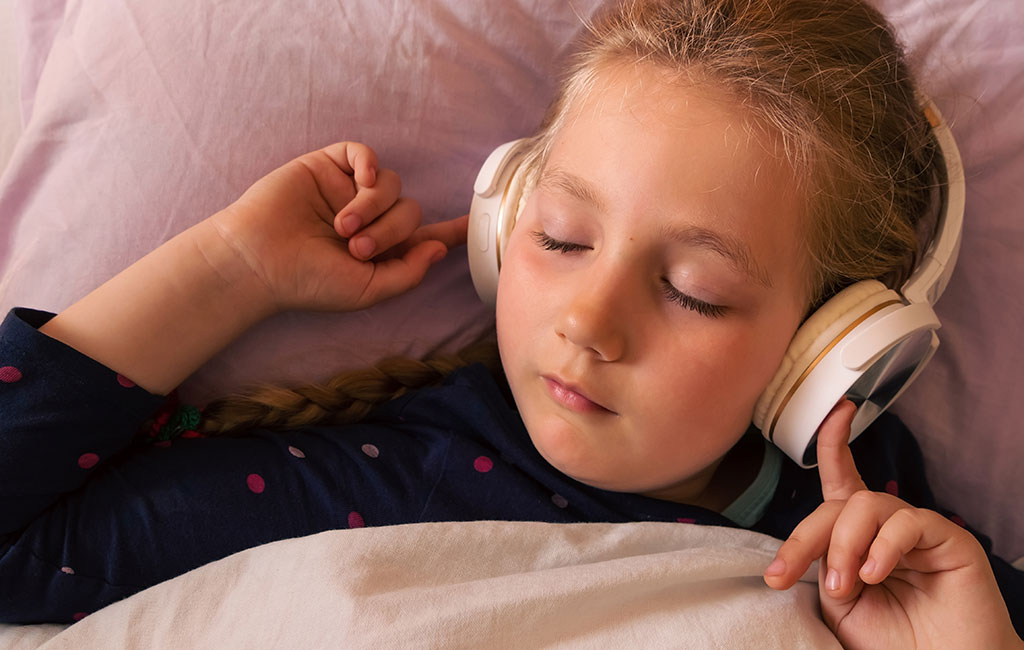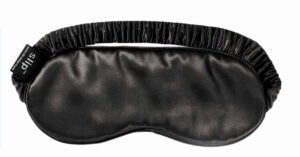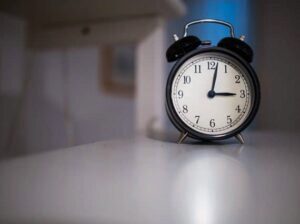Is Sleeping With Headphones on Bad for You?
Disclosure: By clicking on the product links in this article, Mattress Nerd may receive a commission fee at no cost to you, the reader. Read full disclosure statement.
Most people have a rough time sleeping in noisy environments, and headphones are a popular way to block outside noise. Calming sounds, like piano music and white noise, can also help people relax before falling asleep by lowering the heart rate and alleviating stress.
There’s nothing wrong with relying on headphones or AirPods to wind down before bed, but falling asleep with them on poses several health risks. Keep reading to learn about how sleeping with headphones impacts your health. We’ll also share alternative ways to use soothing sounds before bed and list our top picks for headphones that are safely designed to be sleep-friendly.
Dangers of Sleeping With Headphones

While serious injuries involving earphones are rare, sleeping with headphones does pose multiple health risks. Here are the risks associated with sleeping with headphones:
- Hearing Loss—Listening to sounds at a high volume can cause hearing loss overtime, even if the music is peaceful and calming. Experts agree that regularly exposing yourself to volumes higher than 60 decibels can cause hearing damage.
- Otitis Externa—Otitis externa occurs when the skin in the ear canal becomes irritated; this is often the result of wearing headphones that go deeply into the ear canal. Fluid may begin to leak in the ear canal as the earbuds rub against the inside of the year, causing inflammation that can be painful.
- Buildup of Earwax—When you wear headphones at night, it can block air circulation in and around your ears, which leads to ear wax becoming firmly packed into the ear canal. This is especially true of earbuds and can be problematic in the long run.
- Strangulation Hazard—Headphones with wires can wrap around your throat or limbs while you sleep. If you toss and turn or are a combination sleeper, a headphone wire could become wrapped around your body, blocking airways.
- Unaware of Emergencies—Sleeping with headphones at night may cause you to miss the signs of a fire, break-in, medical issue or other emergency situation.
Sleeping with AirPods
Sleeping with wireless earbuds like AirPods can be a convenient way to listen to music, podcasts, or soothing sleep sounds. However, wearing AirPods overnight comes with both advantages and potential risks.
Alternatives to Headphones and AirPods at Night
The common goals shared by people who use headphones at night are typically to relax and to fall asleep faster. Below, we share effective alternatives to fall asleep at night. There’s a list of musical alternatives for people who find sound most effective for falling asleep and a list of non-musical alternatives for people who are open to exploring other methods of relaxing at the end of the day.
Musical Alternatives to Headphones:
- Earplugs—An inexpensive alternative to headphones, foam earplugs usually cost as little as $10 for a box of 100 pairs. To use them, compress them with your fingers and put them into your ear canal. They’ll expand into a noise-blocking seal once in place. Keep in mind that, like headphones, frequent earplug use can lead to minor problems in the long run.
- Noise Cancelling Headphones—Noise cancelling headphones are now available in flat designs that suit any sleeping position. Unlike traditional earbuds, these headphones have an over-ear design that helps sleepers avoid health risks.
- Using a Smartphone—Consider playing the same sleep music or sounds you enjoy on your smartphone at night. Subscription apps like Spotify and Apple Music have pre-selected sleep-friendly playlists, but there are also free apps that offer sleep sounds, white noise, and calming music. Coffitivity, myNoise, and Sleep Fan are a few popular options.
- Bluetooth Speaker—If your phone’s speaker is too quiet, consider purchasing a wireless bluetooth speaker. Most have at least a 50-foot range and cost less than $100. The advantage of a bluetooth device is that it works anywhere, whether you’re at home, in a hotel room or camping outdoors.
Non-Musical Alternatives to Headphones:
- Meditate—Meditation can help calm restless bodies and minds by encouraging general awareness and a focus on the breath. If you’ve never meditated before, a monthly subscription to meditation smartphone app can help you get started. An app called Headspace is among the most popular; it provides guided courses and meditations by topic for issues such as restlessness, work-induced stress and anxiety.
- White Noise Machine—White noise refers to random sounds that produce a soothing, ambient sensation while blocking outside noise. If you’ve been listening to white noise through headphones to fall asleep, consider purchasing a white noise machine instead. These machines are widely available at popular retail stores like Amazon, Target and Walmart and typically cost less than $50.
- Mindful Exercise—While high-intensity workouts like HIIT, weightlifting, and running make it harder to fall asleep, gentle exercise that slows the heart rate, encourages breathing control and promotes relaxation can signal to the body that it’s time to fall asleep. Consider a gentle 30-minute stretch or slow yoga session before bed in lieu of listening to music through headphones.
- Natural Supplements—If you require a little extra help to get deep sleep, there are natural supplements that have been proven by science to help you fall asleep faster. Melatonin, for example, is a hormone your body produces naturally that signals to your brain that it’s time to sleep. Other safe options include magnesium, valerian root and lavender oil.
- Lifestyle Changes—If you’ve become reliant on music to fall asleep, consider gradually making lifestyle changes that can make it easier to fall asleep no matter where you are, what you have access to or what’s playing in the background. Giving yourself dedicated wind-down time, turning off electronic devices, reading and turning the temperature down one hour before bed are effective habits to begin incorporating.
Should Kids Sleep with Headphones?

Navigating sleep for children can be a delicate issue, and most parents consider getting a child to sleep a success no matter how it’s achieved. As a result, adolescents and teens who wear headphones or earbuds to bed can go unnoticed; the same issues that can plague adults who sleep with headphones pose risks for children.
If you’ve noticed that your child enjoys using headphones to fall asleep, considering buying them a bluetooth speaker to put beside their bed, suggesting that they play music softly on a stereo system or investing in a pair of sleep-safe headphones.
Bottom Line
Ultimately, wearing in-ear headphones or Airpods to bed every once in a while isn’t too harmful, but if your sleep routine involves nightly earbud wear, it might be time to consider an alternative option. On-ear and headband headphone designs can give you all the noise cancellation, relaxation and calming benefits of traditional headphones without the risks to your eardrums, outer ears and your overall hearing.
Consider one of the breathable headband headset or thin earbud options we recommended that are safe for sleep, or take your health one step further and opt for an alternative noise source, like a Bose bluetooth speaker, your phone or a white noise machine. If you’re regularly struggling to get a good night’s sleep, these tips can help you break the pattern.


